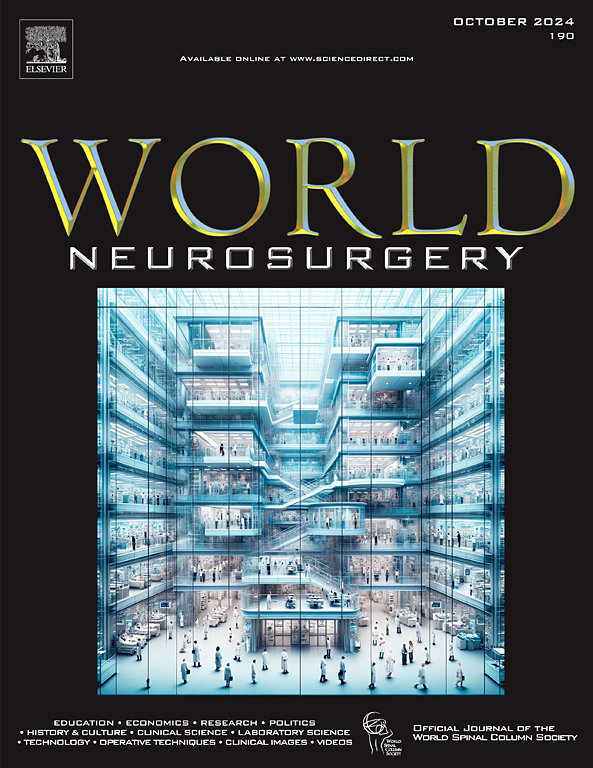较高的Oswestry失能指数改善可使体质虚弱的患者在腰椎融合术后满意。
IF 2.1
4区 医学
Q3 CLINICAL NEUROLOGY
引用次数: 0
摘要
目的:确定接受腰椎融合手术的虚弱患者实现患者满意度所需的Oswestry残疾指数(ODI)改善程度方法:在这项回顾性研究中招募了2020年6月至2022年7月连续接受腰椎融合手术的患者。包括患者特异性和手术特异性变量。评估基线和3个月ODI。术后1年评估患者满意度。采用调整年龄、性别和BMI的多变量logistic回归来确定虚弱对患者满意度的影响。接受者操作特征分析确定了相对ODI改善和术后ODI指示患者满意度的阈值。结果:共纳入418例患者,平均年龄70.4±11.1岁。术前基线ODI中位数为57.5[37.5-65.0],术后3个月ODI为17.5[7.5-27.7]。ODI改善的中位数为42.5[22.5-53.1],相对ODI改善为68.7[41.2-75.3]。在非/体衰前期患者中,基线ODI较高的个体(OR 1.24, 95% CI 1.04-1.64, p < 0.001)术后满意度的概率显著较高。然而,在体弱患者中,基线ODI较低的个体(OR 0.92, 95% CI 0.87-0.96, p < 0.001)更容易获得术后满意度。在非虚弱/前期患者中,术后ODI评分≤26,敏感性为80%,特异性为71%,或相对ODI改善≥55%,敏感性为74%,特异性为68%与患者满意度相关。因此,在体弱患者中,术后ODI评分≤17,敏感性为75%,特异性为65%,或ODI相对改善≥67%,敏感性为71%,特异性为69%与患者满意度相关。在体弱组中,术前ODI较低的患者术后满意度显著高于非体弱组,而术前ODI较高的患者术后满意度显著高于体弱组。体弱组相对ODI改善≥67%或术后ODI≤17表明患者满意;非体弱组相对ODI改善≥55%或术后ODI≤26表明患者满意。本文章由计算机程序翻译,如有差异,请以英文原文为准。
Higher Improvement in Oswestry Disability Index Is Appropriate to Increase Satisfaction of Frail Patients After Lumbar Fusion Surgery
Objective
To determine extent of improvement in the Oswestry Disability Index (ODI) required to achieve patient satisfaction among frail patients undergoing lumbar fusion surgery.
Methods
This retrospective study recruited consecutive patients who underwent lumbar fusion surgery from June 2020 to July 2022. Patient- and procedure-specific variables were included. Baseline and 3-month ODI was assessed. Patient satisfaction was assessed at 1 year after surgery. Multivariable logistic regression adjusting for age, sex, and body mass index was conducted to determine the impact of frailty on patient satisfaction. Receiver operating characteristic analysis determined threshold values for relative ODI improvement and postoperative ODI indicative of patient satisfaction.
Results
The final analysis included 418 patients with mean (SD) age of 70.4 (11.1) years. Median [interquartile range] baseline preoperative ODI was 57.5 [37.5–65.0] with ODI of 17.5 [7.5–27.7] at 3 months after surgery. Median improvement in ODI was 42.5 [22.5–53.1], and relative ODI improvement was 68.7 [41.2–75.3]. Among nonfrail/prefrail patients, those with higher baseline ODI (odds ratio 1.24, 95% confidence interval 1.04–1.64, P < 0.001) had significantly higher probability of experiencing postoperative satisfaction. However, frail patients with lower baseline ODI (odds ratio 0.92, 95% confidence interval 0.87–0.96, P < 0.001) were more likely to experience postoperative satisfaction. In nonfrail/prefrail patients, postoperative ODI ≤26 with sensitivity of 80% and specificity of 71% or relative ODI improvement ≥55% with sensitivity of 74% and specificity of 68% was associated with patient satisfaction. Accordingly, in frail patients, postoperative ODI ≤17 with sensitivity of 75% and specificity of 65% or relative ODI improvement ≥67% with sensitivity of 71% and specificity of 69% was linked to patient satisfaction.
Conclusions
Frail patients with lower preoperative ODI were significantly more likely to experience postoperative satisfaction, whereas nonfrail/prefrail patients with higher preoperative ODI were significantly more likely to experience postoperative satisfaction. Among frail patients, relative ODI improvement ≥67% or postoperative ODI ≤17 indicated patient satisfaction; in nonfrail/prefrail patients, relative ODI improvement ≥55% or postoperative ODI ≤26 indicated patient satisfaction.
求助全文
通过发布文献求助,成功后即可免费获取论文全文。
去求助
来源期刊

World neurosurgery
CLINICAL NEUROLOGY-SURGERY
CiteScore
3.90
自引率
15.00%
发文量
1765
审稿时长
47 days
期刊介绍:
World Neurosurgery has an open access mirror journal World Neurosurgery: X, sharing the same aims and scope, editorial team, submission system and rigorous peer review.
The journal''s mission is to:
-To provide a first-class international forum and a 2-way conduit for dialogue that is relevant to neurosurgeons and providers who care for neurosurgery patients. The categories of the exchanged information include clinical and basic science, as well as global information that provide social, political, educational, economic, cultural or societal insights and knowledge that are of significance and relevance to worldwide neurosurgery patient care.
-To act as a primary intellectual catalyst for the stimulation of creativity, the creation of new knowledge, and the enhancement of quality neurosurgical care worldwide.
-To provide a forum for communication that enriches the lives of all neurosurgeons and their colleagues; and, in so doing, enriches the lives of their patients.
Topics to be addressed in World Neurosurgery include: EDUCATION, ECONOMICS, RESEARCH, POLITICS, HISTORY, CULTURE, CLINICAL SCIENCE, LABORATORY SCIENCE, TECHNOLOGY, OPERATIVE TECHNIQUES, CLINICAL IMAGES, VIDEOS
 求助内容:
求助内容: 应助结果提醒方式:
应助结果提醒方式:


